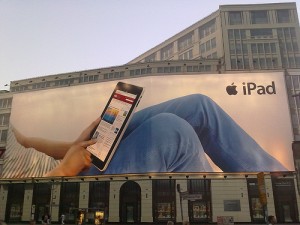 In case you hadn’t noticed, there is a new trend emerging with online advertising that’s more content focused and more in tune with the idea of conversing with the viewer rather than the standard practice of overt one-way advertising.
In case you hadn’t noticed, there is a new trend emerging with online advertising that’s more content focused and more in tune with the idea of conversing with the viewer rather than the standard practice of overt one-way advertising.
The reason is simple, most of us have learned how to ignore online banner ads and those annoying animated ads that jump out at us as we click on a new page. Most people hate these ads and all of the obstacles that prevent us from immediately accessing the content we are seeking.
As Chris Anderson, curator from the non-profit group TED, recently stated, “online ads are not adding anything to our web surfing experience. Rather, they are annoying us, boring us, and even enraging us.†Instead advertisers should be seeking to join the online community by sharing information and providing worthy content as well as joining in the conversation.
“We’re moving toward a future where advertisers and consumers are part of the same community, sharing ideas and engaging in a learning cycle, together,†Anderson continued and went on to advocate that advertisers should create ads that are worth spreading. “We (at TED) want to encourage development of ads-with-a-difference… that engage our audience authentically, intelligently and delightfully. Ads that people will want to share because they encapsulate ideas worth spreading.”
This idea isn’t new. The 25-year tradition of the highly anticipated Super Bowl ads may well fit into this category of engagement where viewers actually look forward to seeing the commercials. It makes one ask why advertisers don’t create worthy TV spots all the time?
Non-Traditional Advertising Methods
At any rate, the idea now is to become part of the conversation. Advertisers need to engage prospects with credible content that isn’t overt, intrusive or just blatant in-your-face advertising. Those marketers that succeed in this evolving arena will likely be embraced by viewers and may ultimately create loyal consumers as a result.
A couple of months ago Science Creative posted an article on Danny MacAskill’s amazing bike riding videos that were sponsored by Red Bull, VW and other advertisers who sponsored his breathtaking stunts. This form of advertising is low key where the advertiser isn’t prominent during the spot. The talent is the content which is what attracts viewers and in-turn, makes the video go viral. The product/brand association with Danny’s talent is subtle but effective simply because it’s deliberately set in the background.
Flash Mobs Making an Impact?
 Another form of subtle online marketing that advertisers are beginning to take notice of are “spontaneous†events such as flash mobs. Many of these social media engineered events have a track record of going viral on YouTube and Vimeo and (if done well by advertisers) can lead to some excellent exposure. But do they work? In December 2010, Air Canada presented a Christmas flash mob at Vancouver International Airport that went viral. According to the number of positive comments posted on the YouTube wall, it seemed to have worked well as a “good will” gesture for Air Canada.
Another form of subtle online marketing that advertisers are beginning to take notice of are “spontaneous†events such as flash mobs. Many of these social media engineered events have a track record of going viral on YouTube and Vimeo and (if done well by advertisers) can lead to some excellent exposure. But do they work? In December 2010, Air Canada presented a Christmas flash mob at Vancouver International Airport that went viral. According to the number of positive comments posted on the YouTube wall, it seemed to have worked well as a “good will” gesture for Air Canada.
However, it’s important for advertisers to understand that this practice must be authentic and the events should in no way be perceived as being purposely staged by a corporate entity for financial gain. That means any branding should be subtle if not non-existent during the event. Of course this idea goes against common marketing practice, but the end result is being able to join in a conversation that may have far more potential. These kinds of sponsored videos will no doubt produce some negative comments by viewers, but if handled correctly, they can be viewed as an opportunity to connect and converse with potential customers.
Advertisers Must Now Engage in Two-Way Conversations
Because most advertisers are accustomed to the traditional one-way conversation where they beg, ambush and cajole online viewers to click on their ads and banners, their decades old mindset (from the Mad Men era) has been squarely focused on selling their product and announcing their presence while rarely offering anything “valuable†in return.
 When one considers the rapid social and technological changes that have taken place over the past three years primarily due to the rise of social media, mobile smart phones and of course the iPad, the old model of “connecting” with consumers is now being rethought if only because we have so many choices available. The fact is no real new advertising business model exists yet simply because these changes are occurring faster than the industry can keep up.
When one considers the rapid social and technological changes that have taken place over the past three years primarily due to the rise of social media, mobile smart phones and of course the iPad, the old model of “connecting” with consumers is now being rethought if only because we have so many choices available. The fact is no real new advertising business model exists yet simply because these changes are occurring faster than the industry can keep up.
What we do know is that online consumers have more power now than ever. The December Wikileaks episode where angry protesters temporarily crippled the Visa website and several others is evidence that this power can be unleashed at anytime.
The iPad: What Else Can We Expect?
Only a few months after entering the market iPad’s are now becoming commonplace in businesses, homes, schools* and many restaurants have also begun using them as menus that include specialized wine lists. The point here is that there are now (and will continue to be) many, many opportunities to connect with consumers using this new media and most of it will NOT be in the form of a one-way advertisement. (*Obviously when communicating with children it’s not acceptable to advertise any products in a school setting, however if valuable educational content is created [with no strings attached] then this could be helpful.)
 One may easily forget that it was only 3 1/2 years ago when no one knew what an App was. Now, all smart phones and tablets have access to thousands of these programs that have changed the way we shop, commute, search for restaurants and just about everything else. The saying “There’s an app for that†is no longer surprising to anyone. Many advertisers are only just beginning to see where they can fit in and connect with consumers with so many new platforms coming online. Through it all, it’s important for advertisers to remember that authentic engagement and providing credible and valuable content will be vital as the most popular of these new apps become widely accepted and used.
One may easily forget that it was only 3 1/2 years ago when no one knew what an App was. Now, all smart phones and tablets have access to thousands of these programs that have changed the way we shop, commute, search for restaurants and just about everything else. The saying “There’s an app for that†is no longer surprising to anyone. Many advertisers are only just beginning to see where they can fit in and connect with consumers with so many new platforms coming online. Through it all, it’s important for advertisers to remember that authentic engagement and providing credible and valuable content will be vital as the most popular of these new apps become widely accepted and used.
2011 And Beyond
Advertising in 2011 and beyond is quickly becoming a shared practice between the advertiser and the consumer where content is king and genuine authenticity is what will separate the new age savvy marketers from the needy traditionalists who are blind to the habits of today’s consumers.